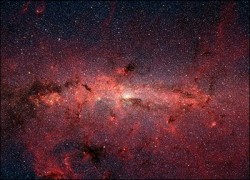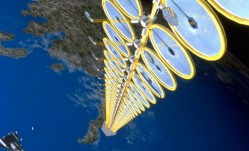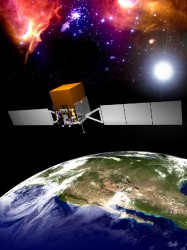 The Milky Way is a large place, and getting all the stars together, even from just the inner galaxy, for a family photo requires a big canvas. The imaging team from the Spitzer Space Telescope today unveiled the largest, highest resolution infrared picture ever taken of the Milky Way. The photo spans 55 meters (180 feet), and takes up almost one entire wall in the huge exhibit hall here at the AAS meeting in St. Louis (above.) The image is made of 800,000 snapshots taken by Spitzer, amassing 39,000 X 6000 pixels, and shows an area of sky 120 degrees longitude by 2 degrees latitude. It provides 100 times better angular resolution than any previous survey and is 100 times more sensitive. There's also an online version….
The Milky Way is a large place, and getting all the stars together, even from just the inner galaxy, for a family photo requires a big canvas. The imaging team from the Spitzer Space Telescope today unveiled the largest, highest resolution infrared picture ever taken of the Milky Way. The photo spans 55 meters (180 feet), and takes up almost one entire wall in the huge exhibit hall here at the AAS meeting in St. Louis (above.) The image is made of 800,000 snapshots taken by Spitzer, amassing 39,000 X 6000 pixels, and shows an area of sky 120 degrees longitude by 2 degrees latitude. It provides 100 times better angular resolution than any previous survey and is 100 times more sensitive. There's also an online version….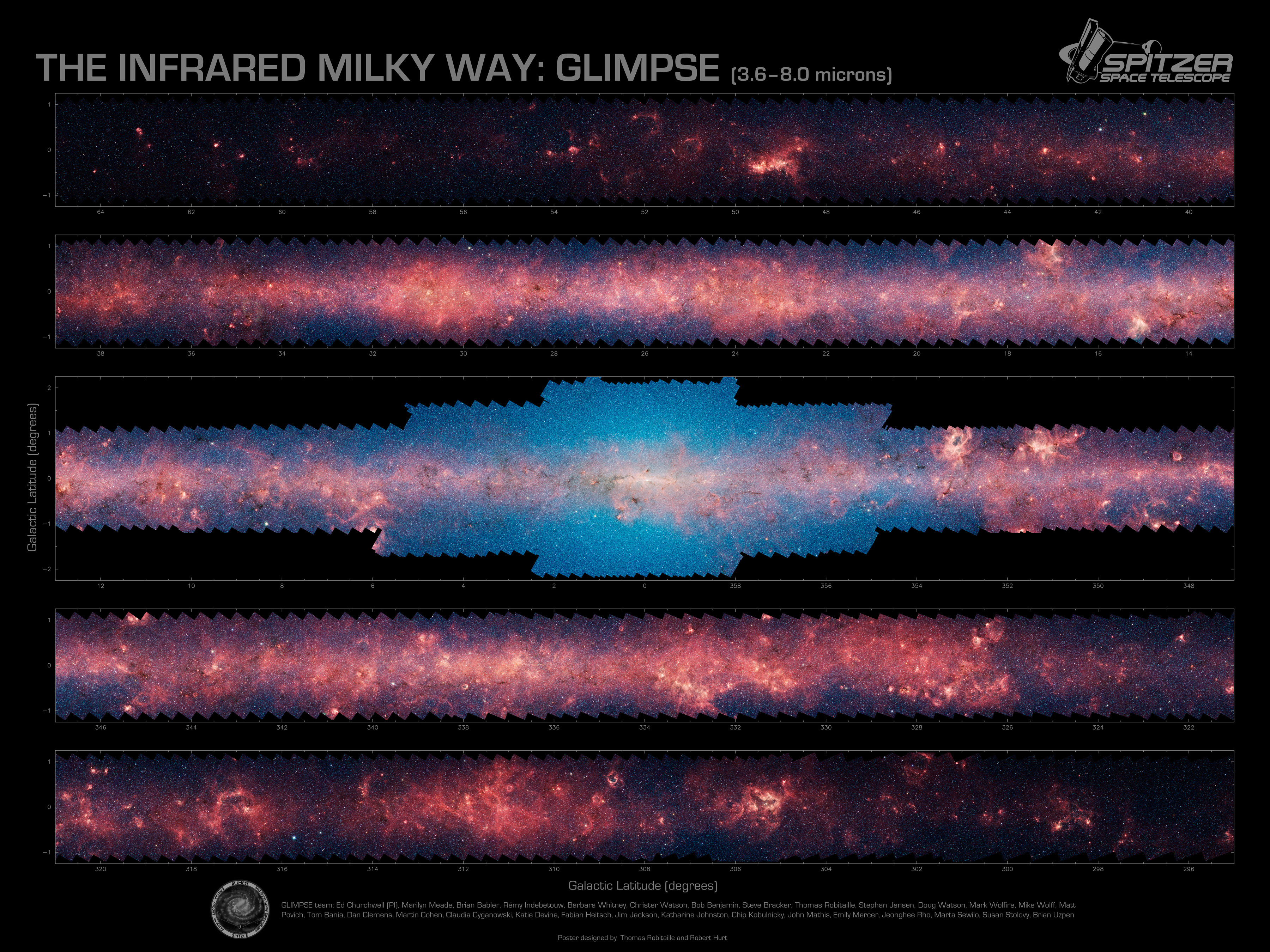
This "chops" up the image into five strips, and certainly isn't as impressive as the 55 meter version! However, there's another, more spectacular way to view this spectacular image. The GLIMPSE (Galactic Legacy Infrared Mid-Plane Survey Extraordinaire) Image Viewer provides a great way to view and browse this image. The viewer boasts the following tagline: "One spacecraft, 5 infrared bands, 800,000 images, 4 billion pixels of data." It lets you scan the image with both the IRAC (Infrared Array Camera) on Spitzer, or the MIPS (Multiband Imaging Photometer.)
Other Article About This Blog
Jumat, 06 Juni 2008
Diposting oleh
dazchild
di
02.43
![]()

If you were stuck inside your house, you'd never know what it looks like from the outside. That's the situation with the Milky Way. We're inside it, so we don't really know what its structure looks like. There are other examples of grand spirals that we can see, but this is like seeing other houses outside your window; you just can't be sure. Astronomers have developed a detailed map of the Milky Way, and realized that they were giving our home galaxy too many arms; it's only got 2, and not 4 like astronomers originally thought.
The new revelation was made possible thanks to NASA's Spitzer Space Telescope, which sees in the infrared spectrum, and can peer though the gas and dust that obscures the plane of the Milky Way.
Previous maps of the Milky Way were first developed in the 1950s, when astronomers used radio telescopes to trace out the spiral arms of our home galaxy. They focused on gas clouds, and revealed what they thought were 4 major star-forming arms: Norma, Scutum-Centaurus, Sagittarius and Perseus.
We live in minor arm called the Orion Arm, or the Orion Spur, located between the Sagittarius and Perseus Arms.
And then in 2005, astronomers used infrared telescopes to pierce through the clouds of gas and dust to see that the central bar in the middle of the Milky Way extends much further than previously believed.
In a new survey by Spitzer, astronomers merged together 800,000 photographs containing over 110 million stars. Software counted up the number of stars and measured their density.
As expected, astronomers found an increase in density in stars towards the Scutum-Centaurus Arm, but no increase towards the Sagittarius and Norma arms. The Perseus arm wraps around the outer portion of our galaxy and can't be seen in the Spitzer images.
This helps make the case that the Milky Way only has two spiral arms; a commonly seen situation where a galaxy has a long central bar.
Diposting oleh
dazchild
di
02.37
![]()
Japan space lab anchored to ISS
A team of astronauts has attached a $1bn (£500m) Japanese laboratory to the International Space Station (ISS).
The 15-tonne Kibo lab was delivered by the shuttle Discovery. It will be the station's biggest room, for the study of biomedicine and material sciences.
Astronauts Akihiko Hoshide and Karen Nyberg manoeuvred Kibo into place, using the space station's robotic arm.
The lab was anchored after two crew members had made preparations during a spacewalk lasting more than six hours.
Discovery docked at the ISS on Monday after a two-day voyage.
As well as the Japanese laboratory, the shuttle has also brought a new pump for the station's toilet, which broke nearly two weeks ago.
The failure has resulted in the resident crew on the ISS having to perform manual flushes several times a day.
The lab was moved into place using a mechanical arm
The Kibo Japanese Pressurised Module (JPM) is the size of a bus and joins the US Destiny lab and the European Columbus lab which are already attached to the platform.
Kibo is so big it could not be fitted inside a single shuttle and is being assembled in three parts. A logistics module went up on the previous shuttle flight; an exposed "terrace" on which experiments can be done outside of the station will launch in 2009.
The logistics module will be moved from its current docking position to a berthing point on the JPM later in Discovery's mission. All of its contents - experimental racks and equipment - can then be moved inside the 11.2m-long cylinder to get the module ready for science.
Kibo experiments will make use of the weightless conditions experienced in orbit.
Being able to see how biological, chemical and physical systems behave in the absence of a strong gravity field will help researchers better understand how the human body works and aid their search for materials that display useful new properties.
The Discovery flight has also delivered Canadian-born astronaut Greg Chamitoff, who will replace flight engineer Garrett Reisman as a station resident for the next six months.
Discovery also carried up a VIP - the space ranger Buzz Lightyear.
The 30cm-tall (12in) action figure, made famous in the Disney/Pixar Toy Story movies, went into orbit as part of an educational programme.
Nine further shuttle flights are required to complete the ISS before the orbiter fleet is retired in 2010.
Discovery's return to Earth is scheduled for 14 June.Source: http://news.bbc.co.uk/1/hi/sci/tech/7432466.stm
Diposting oleh
dazchild
di
02.35
![]()
So, What Do Astronomers Do With A 55 Meter-Long Image?
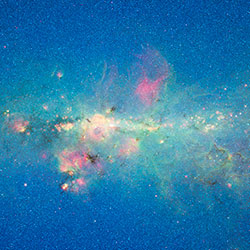
The new 55-meter image that was unveiled today is impressive, but does it hold any scientific value? A resounding yes to that question came from astronomers who helped work on this project, and given the standing room only for the oral presentation of the scientific research going into this image, plenty of other astronomers are interested in the discoveries from Spitzer's five-year effort of gathering infrared data of our home galaxy. "This is a legacy science project," said Barbara Whitney of the Space Science Institute, "that shows star formation as never seen before on both the large and small scale. Most of these star forming regions are being seen for the first time."
"This is the highest-resolution, largest, most sensitive infrared picture ever taken of our Milky Way," said Sean Carey of NASA's Spitzer Science Center. "Where previous surveys saw a single source of light, we now see a cluster of stars. With this data, we can learn how massive stars form, map galactic spiral arms and make a better estimate of our galaxy's star-formation rate," Carey explained.
From our vantage point on Earth, we see the Milky Way as a blurry, narrow band of light that stretches across the sky. In the visible, we only see about 5% of what's actually out there. But with Spitzer's dust-piercing infrared eyes, astronomers have peered 60,000 light-years away into this fuzzy band, called the galactic plane, and saw all the way to the other side of the galaxy.
The result is a cosmic tapestry depicting an epic coming-of-age tale for stars.
While evolved stars are seen as blue, the star forming regions are seen as green. The regions where young stars reside are revealed as "bubbles," or curved ridges in the green clouds. These bubbles are carved by the winds from the outflow of dust from the young stellar objects. The starlets appear as yellow and red dots, and wisps of red are dust particles.
"With these Spitzer data, we've been able to catalogue more than 100 million stars," said Edward Churchwell of the University of Wisconsin, at Madison.
"This picture shows us that our Milky Way galaxy is a crowded and dynamic place. We have a lot to learn. I've definitely found a lot of things in this map that I didn't expect to see," said Carey.
Source : http://www.universetoday.com/2008/06/03/so-what-do-astronomers-do-with-a-55-meter-long-image/
Diposting oleh
dazchild
di
02.33
![]()
Milky Way Mapping Project Finds Surprisingly Slow Stars
Now, ultra-precise radio measurements using the National Science Foundation's Very Long Baseline Array (VLBA) have given astronomers their first good look at the structure of the Milky Way and the motions of its young stars. Already, the measurements have turned up a big surprise: the mapped stars are orbiting slower than expected and moving in looping, oval paths rather than circling the galactic center.
"Almost all of our targets seem to have been accelerated opposite the direction of the galaxy's rotation," said Smithsonian astronomer Mark Reid (Harvard-Smithsonian Center for Astrophysics.) Reid discussed his findings today in a press conference at the 212th American Astronomical Society meeting.
Reid speculated that the accelerating force came from the galaxy's spiral arms. The Milky Way's spiral pattern comes from a phenomenon called a density wave, which acts like an astronomical traffic jam. Just as cars stuck behind a slow-moving truck catch up to each other and slow down, gas clouds approaching a spiral arm catch up to each other and slow down. They also compress, birthing the hot, young stars that Reid studied.
The slowing motion and resulting loss of angular momentum shift the stars' orbits from circular to elliptical. Since previous efforts to map the Milky Way assumed that stars orbit in circles, the resulting maps have intrinsic errors.
Reid used the VLBA to measure the parallax, or apparent shift in position on the sky as the Earth orbits the Sun, for masers in about a dozen star-forming regions. He then applied basic geometry to calculate highly accurate distances to each region. He also was able to observe the motion of each maser in the plane of the sky. Combining those data with motions along the line of sight yielded the true, 3-d motion of each target through space.
The VLBA's capabilities were crucial to this project. "The VLBA runs so smoothly that it makes my work easy," Reid said.
He added that the accuracy of the VLBA exceeds that of any other mapping instrument. "The previous gold standard, the Hipparcos satellite, could measure positions of stars to an accuracy of 1 milli-arcsecond. We're doing 100 times better with the VLBA."
Reid and his colleagues in Germany, Italy, and China plan to continue this mapping project by racking up several dozen more targets in the years to come. Ultimately, this work will help answer basic questions about the structure of the Milky Way.
"We don't even know how many spiral arms the Milky Way has-two or four," Reid explained.
Reid also looks forward to the launch of Hipparcos' successor, the European Space Agency's spacecraft Gaia. It will map the positions of up to 1 billion stars located as far as 30,000 light-years from Earth.
"Right now, our map of the Milky Way still has large areas marked 'Here there be dragons.' Ten years from now, those areas will be filled in," Reid said.
The National Radio Astronomy Observatory is a facility of the National Science Foundation, operated under cooperative agreement by Associated Universities, Inc.
Headquartered in Cambridge, Mass., the Harvard-Smithsonian Center for Astrophysics (CfA) is a joint collaboration between the Smithsonian Astrophysical Observatory and the Harvard College Observatory. CfA scientists, organized into six research divisions, study the origin, evolution and ultimate fate of the universe.For more information, contact:
David A. AguilarDirector of Public Affairs
Harvard-Smithsonian Center for Astrophysics
617-495-7462
daguilar@cfa.harvard.edu
Christine Pulliam
Public Affairs Specialist
Harvard-Smithsonian Center for Astrophysics
617-495-7463
cpulliam@cfa.harvard.edu
Diposting oleh
dazchild
di
02.28
![]()
Toilet is Fixed and Kibo is Switched On - A Great Day Aboard the ISS (Video)
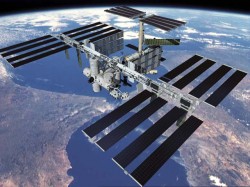
It has been a very good day for the crew on board the International Space Station. Not only has the brand new Japanese Kibo science laboratory been activated, much to the crew's relief, the faulty toilet has also been fixed. Russian flight engineer Oleg Kononenko was able to replace the broken urine collection pump in a 2 hour repair job yesterday (Wednesday) and specialists in Moscow checked his work to verify it was working fine. Although this may sound like a bit of minor news, it was make-or-break time for the ISS as if the repair was unsuccessful, this may have seriously hindered the manned presence on the station (and besides, we haven't even had time to play with Kibo yet!)…
It looks like the replacement part for the ISS toilet is working as it should after it was delivered by Discovery on June 2nd. Cosmonaut Oleg Kononenko successfully carried out the technical plumbing job and all seems to be flushing as it should. Although a toilet fix in space may not seem like a critical factor, 10-days without a functioning toilet on board the ISS have been difficult for the crew. Until now, all crew members have had to make do with the single toilet facility on board the Russian Soyuz vessel currently docked at the station. It is fortunate the break-down happened when it did, with enough time for the Russian space agency to send replacement parts to the US in time for Space Shuttle Discovery's launch last weekend.
As Kononenko worked on the unglamorous task of fixing the toilet, the other astronauts were working on installing Kibo. All connections from Kibo to the station had to be made, including water supply, power and air, and today it was pressurized and powered up. The new Kibo science laboratory that was attached to the station on Tuesday following a six-hour spacewalk by two astronauts to prepare for its installation. Everything is looking good and the crew hope to open the hatch, float in and explore the station's brand new science module some time today.
View the Reuters video report about the plumbing trouble on the ISS »
Source: USA Today
Diposting oleh
dazchild
di
02.24
![]()
Highest Resolution View Ever From Mars Comes From Phoenix Lander
June 5, 2008 -- A microscope on NASA's Mars Phoenix Lander has taken images of dust and sand particles with the greatest resolution ever returned from another planet.
The mission's Optical Microscope observed particles that had fallen onto an exposed surface, revealing grains as small as one-tenth the diameter of a human hair.
"We have images showing the diversity of mineralogy on Mars at a scale that is unprecedented in planetary exploration," said Michael Hecht of NASA's Jet Propulsion Laboratory, Pasadena. He is the lead scientist for Phoenix's Microscopy, Electrochemistry and Conductivity Analyzer (MECA) instrument suite.
The Phoenix mission is led by Peter Smith at The University of Arizona with project management at JPL and development partnership at Lockheed Martin, Denver.
Meanwhile, Phoenix received commands Thursday to collect its first soil sample to be delivered to a laboratory instrument on the lander deck. Commands for that same activity sent on Wednesday did not reach Phoenix because the orbiter intended for relaying the transmission, NASA's Mars Odyssey, had put itself into a safe standby mode shortly before the commands would have reached Odyssey.
On Wednesday, the lander completed a back-up plan of activities that had been sent previously, reported JPL's Chris Lewicki, mission manager for Phoenix surface operations on the lander's 11th Martian day. That plan included weather monitoring and additional imaging for a high-resolution color panorama of the site.
The Optical Microscope images were taken June 3 of particles that had collected on a sticky surface exposed during the Phoenix landing and for five days after landing. "It's a first quick look," Hecht said. "This experiment was partly an insurance policy for something to observe with the microscope before getting a soil sample delivered by the arm, and partly a characterization of the Optical Microscope. All the tools are working well."
Some of the particles might have come from inside the spacecraft during the forceful events of landing, but many match expectations for Martian particles. "We will be using future observations of soil samples delivered by the Robotic Arm to confirm whether the types of particles in this dustfall sample are also seen in samples we can be certain are Martian in origin," Hecht said.
The particles show a range of shapes and colors.
"You can see the amount of variety there is in what appears otherwise to be just reddish brown soil," said Tom Pike, Phoenix science team member from Imperial College London. He noted that one translucent particle resembles a grain of salt, but that it is too early to say for sure.
Thursday's commands were relayed to Phoenix via NASA's Mars Reconnaissance Orbiter. The relay radio on that orbiter has been working well in recent days, after intermittently turning itself off last week. Phoenix will continue to do relays via Mars Reconnaissance Orbiter until Odyssey returns to full functioning, and then Phoenix will use both orbiters.
"We are currently bringing the Odyssey spacecraft back into nominal operations, and we will resume relay service with Odyssey in the next day or two," said JPL's Chad Edwards, chief telecommunications engineer for the JPL Mars Exploration Program.
"We think Odyssey went into safe mode because of a single event that affected computer memory," Edwards said. "Yesterday's safe mode event appears to be very similar to events that have caused Odyssey to go into safe mode two or three times earlier during its long operation around Mars." Odyssey has been orbiting Mars since 2001.
International contributions to the Phoenix Mars mission come from the Canadian Space Agency; the University of Neuchatel, Switzerland; the universities of Copenhagen and Aarhus, Denmark; Max Planck Institute, Germany; and the Finnish Meteorological Institute.
Click Here for images shown during this press conference
Source From: http://phoenix.lpl.arizona.edu/06_05_pr.php
Diposting oleh
dazchild
di
02.21
![]()
Senin, 02 Juni 2008
Launchpad Damaged During Saturday's Shuttle Launch
Debris falls into the water during Discovery's launch on Saturday. Image from CBS Space Place.
The launchpad at Kennedy Space Center was damaged during Saturday's space shuttle launch. Pictures taken during Discovery's launch show debris raining down into the waterway just behind launchpad 39A. Additional images show debris that appears to be broken concrete littering a nearby road as well as damaged and buckled concrete on one side of the launchpad. CBS News' Bill Harwood reported that the damage to the pad occured on the north side of the "flame trench" wall. The trench is used to divert exhaust from the shuttle's solid rocket boosters.
The damage is "unusual," Harwood quoted NASA spokesman Bill Johnson, who verified the damage was serious and tomorrow (Monday) a full report on the incident will be issued. Harwood also reported that a NASA manager said part of the pad's base was repaired following a previous launch, but possibly something was either missed or not repaired correctly.
The debris appears to come from the lauchpad itself, and not the shuttle. However, the astronauts on board Discovery have not yet been able to conduct the usual inspection of the shuttle nose cap and wing leading edge panels because the 50-foot-long boom equipped with laser scanners and high-resolution cameras was unable to fit into the shuttle's payload bay due to the large size of the Japanese Kibo laboratory that Discovery is bringing to the International Space Station. The last shuttle crew left the orbiter boom sensor system at the ISS, and the crew of Discovery will retrieve it while docked to the station. ISS crew members will take high resolution pictures of the shuttle as it approaches the station on Monday.
Both launchpads at KSC, 39A and 39B were originally built for the Apollo spacecraft/Saturn rockets and were modified for the space shuttles. During launches the pads must withstand both high heat and extreme pressure.
Original News Source: CBS Space Place
Diposting oleh
dazchild
di
02.17
![]()
It Really Looks Like Ice on Mars
Take a look at this image sent back from the Phoenix lander. On Friday, Phoenix scientist Ray Arvidson said there may be ice directly under the Phoenix lander, exposed in the blast zone by the retrorockets used for Phoenix's soft landing. Friday's image showed a small portion of the exposed area that looks brighter and smoother than the surrounding soil. On Saturday, Sol 5 for Phoenix on Mars, a new image shows a greater portion of the area under the lander. Scientists say the abundance of excavated smooth and level surfaces adds evidence to a hypothesis that the underlying material is an ice table covered by a thin blanket of soil. This is just what the Phoenix mission was hoping to find, and how incredible to land directly over your goal.
The bright-looking surface material in the center, where the image is partly overexposed, may not be inherently brighter than the foreground material in shadow. But the scientists are calling this area "Holy Cow." Reportedly (via Emily at the Planetary Society) that's exactly the phrase exclaimed when this image was returned. More pictures of this feature will be imaged using different exposures in an effort to determine if this really is ice.
The other interesting aspect of this image is that the retrorocket nozzles are visible right at the top of the image.
We'll keep you posted when there's more information and data available on the area under the lander.
Sources: Phoenix, Planetary Blog
Diposting oleh
dazchild
di
02.16
![]()
Harvesting Solar Power from Space
In a new report, the viability of sending solar panels into space to collect a vast quantity of uninterrupted energy has been re-investigated. Although the idea has been around since the 1970's, space solar power has always been viewed as prohibitively expensive. In the current energy climate down here on Earth with spiralling oil prices and a massive push toward green energy sources, sending massive solar arrays into geosynchronous orbit doesn't seem like such a strange (or expensive) idea. There are many obstacles in the way of this plan, but the international community is becoming more interested, and whoever is first to set up an orbital array will have a flexible and unlimited energy resource…
It sounds like the perfect plan: build a vast array of solar panels in space. This avoids many of the practical problems we have when building them on Earth such as land availability, poor light conditions and night time, but sending a sunlight farm into space will be expensive to set up. In the 1970's a plan was drawn up by NASA for the possibility of orbital sunlight "harvesting", but it was deemed too expensive with a hefty price tag of at least $1 trillion. There was no country in the world that could commit to such a plan. But as we slowly approach an era of cheaper space travel, this cost has been slashed, and the orbital solar energy case file has been re-opened. Surprisingly, it isn't the most developed nations in the world that are pushing for this ultimate renewable energy source. India and China, with their ballooning populations are reaching a critical point for energy consumption and they are beginning to realise their energy crisis may be answered by pushing into space.
"A single kilometer-wide band of geosynchronous Earth orbit experiences enough solar flux in one year to nearly equal the amount of energy contained within all known recoverable conventional oil reserves on Earth today." - Pentagon's National Security Space Office 2007 report.
So how could this plan work? Construction will clearly be the biggest expense, but the nation who leads the way in solar power satellites will bolster their economy for decades through energy trading. The energy collected by highly efficient solar panels could be beamed down to Earth (although it is not clear from the source what technology will go into "beaming" energy to Earth) where it is fed into the national grid of the country maintaining the system. Ground based receivers would distribute gigawatts of energy from the uninterrupted orbital supply. This will have obvious implications for the future high demand for electricity in the huge nations in Asia and will wean the international community off carbon-rich non-renewable resources such as oil and coal. There is also the benefit of the flexible nature of this system being able to supply emergency energy to disaster (and war-) zones.
"It will take a great deal of effort, a great deal of thought and unfortunately a great deal of money, but it is certainly possible." - Jeff Keuter, president of the George C. Marshall Institute, a Washington-based research organization.
The most optimistic time frame for a fully operational space-based sunlight collection satellite would be 2020, but that is if we started work now. Indeed some research is being done (Japan is investing millions of dollars into a potential prototype to be put into space in the near future), but this is a far cry from planning to get full-scale operations underway in a little over a decade…
Source: CNN International
Diposting oleh
dazchild
di
02.15
![]()
Get Ready for High-Energy GLAST
It's not hard to grab someone's attention when you mention the words "super massive black holes," "gamma ray bursts," "cosmic rays," and " dark matter." NASA's next space telescope will attempt to grab data about some of these high-energy objects in our universe to help us understand their mysteries. GLAST, the Gamma-ray Large Area Space Telescope will use its instruments to study those objects that generate gamma-ray radiation, the most energetic form of radiation we know of, billions of times more energetic than the type of light visible to our eyes. Liftoff for GLAST is set for Thursday, June 5, and the launch window extends from 11:45 a.m. to 1:40 p.m. EDT.
GLAST will reside in a circular, low Earth orbit of about 560 km ( 350 miles ). This orbit was chosen to minimize the effects of charged particles that surround Earth, and which would create additional unwanted background signals in the detectors. At that altitude, the observatory will circle Earth every 90 minutes. In sky-survey mode, GLAST will be able to view the entire sky in just two orbits, or about 3 hours.
The instruments on the GLAST mission are the Large Area Telescope (LAT) and the GLAST Burst Monitor. Lat has a tracker for gamma-ray detection and direction measurement, and can also measure the energies of the rays. The GBM will have two types of scintillators mounted on the sides of the spacecraft to detect electromagnetic waves.
Phil over at Bad Astronomy has a couple of very nice (and fun) videos with info about GLAST (one starring Phil himself), but these are the major goals of GLAST:
• Explore the most extreme environments in the Universe, where nature harnesses energies far beyond anything possible on Earth.
• Search for signs of new laws of physics and what composes the mysterious Dark Matter.
• Explain how black holes accelerate immense jets of material to nearly light speed.
• Help crack the mysteries of the stupendously powerful explosions known as gamma-ray bursts.
• Answer long-standing questions across a broad range of topics, including solar flares, pulsars and the origin of cosmic rays.
GLAST should provide some very interesting data about these spectacular and remarkable objects in our universe, and will create a full-sky map of gamma radiation.
Kapla GLAST!
Source: GLAST site
Diposting oleh
dazchild
di
02.11
![]()





 RSS Feed (xml)
RSS Feed (xml)
